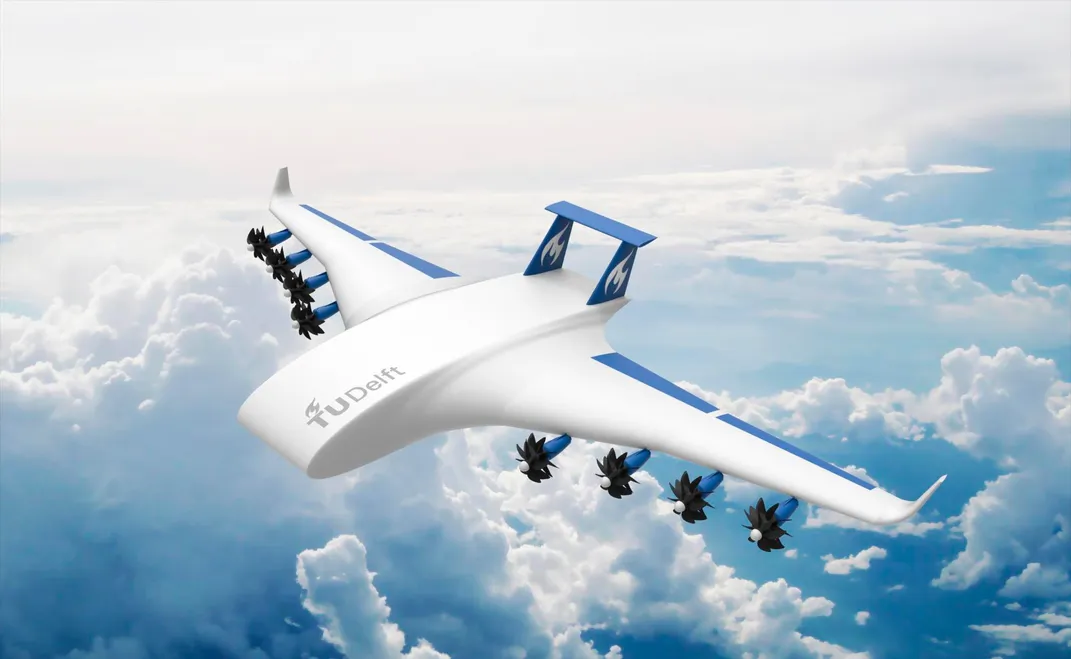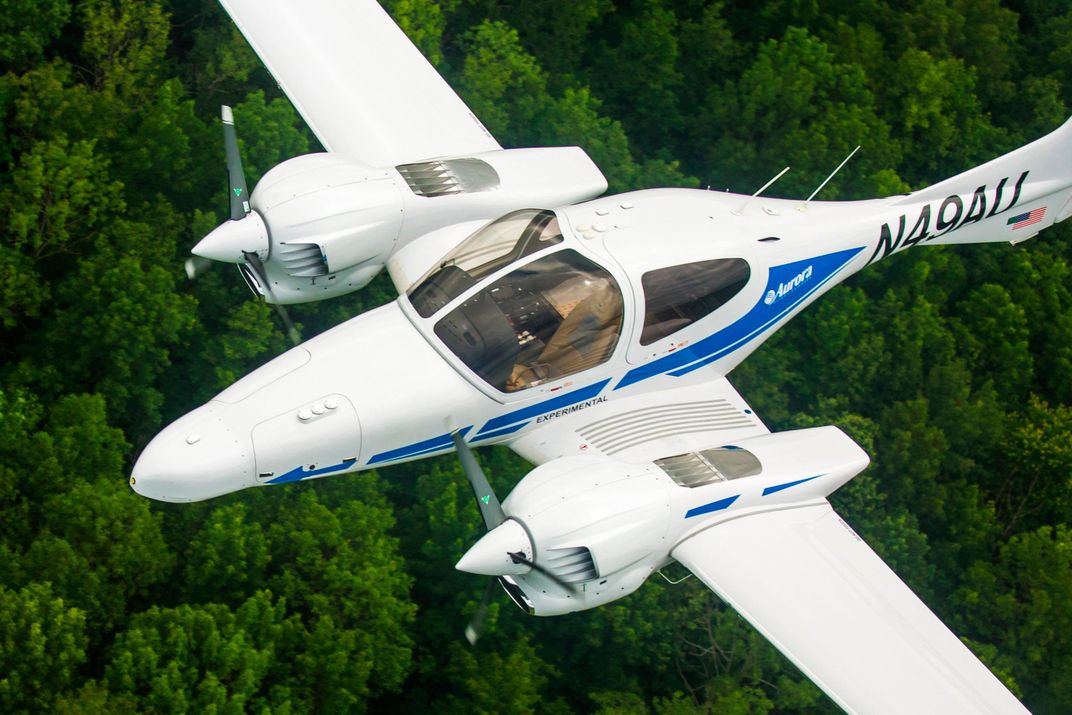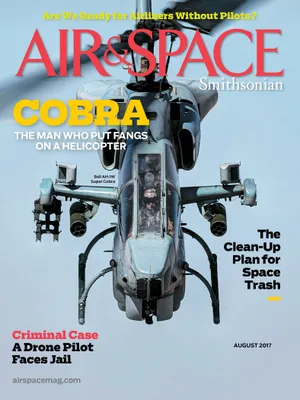Would You Fly on an Airliner Without a Pilot?
Studies show that with technology available today, you could.
:focal(932x402:933x403)/https://tf-cmsv2-smithsonianmag-media.s3.amazonaws.com/filer/62/d8/62d84280-33ba-4cba-8121-20da8e576adc/emptyairbuscockpit.jpg)

Now that there are more drones in the air than Cessnas, and the U.S. Navy has deployed remotely piloted combat helicopters that can make carrier landings at sea, how long before airline pilots go the way of elevator operators and travel agents?
John Deaton, an ex-Navy aviator who chairs the human factors program in the College of Aeronautics at the Florida Institute of Technology, offers an answer: “I think we will eventually get down to one pilot in the cockpit, but I don’t see us ever going to unmanned airliners. People are going to demand that somebody is responsible [for flying the airplane].” Missy Cummings, a former Navy F/A-18 pilot, director of the Humans and Autonomy Lab at Duke University and a frequent spokeswoman for automation, offers another: “The reality is that airplanes already have the technology to fly themselves without a human pilot in the cockpit.” John Hansman, a professor of aeronautics and astronautics at the Massachusetts Institute of Technology, says, “The issue has never been ‘Could you automate an airplane and fly it autonomously?’ The issue is ‘Could you put paying customers in the back of that airplane?’ ”
And there, roughly, is where the discussion has stalled.
All agree that automation has benefits for an airline. Autopilots conserve fuel better than human pilots do. Computers don’t get tired or bored or have a bad day. They’re a lot cheaper to maintain and easier to produce than real, live pilots, who are already in short supply among U.S. regionals. Humans in the cockpit could even be seen as a hazard. Research shows that about three-quarters of all airline accidents are the result of pilot error. This calculation doesn’t include the damage that can be caused by a rogue actor, such as the suicidal copilot who flew Germanwings Flight 9525 into a mountain in 2015, killing 150 passengers and crew members. And a computer would never show up for work drunk, as a SkyWest Airlines pilot is alleged to have done when he tried to board his flight in Rapid City, South Dakota, in October 2016.
On the other hand, these bad actors are the exceptions that prove the rule of professionalism among the majority of pilots. And there’s no guarantee that airliners flown by a computer would be any safer. Who writes the software? Fallible human beings.
**********
Airlines have already substantially reduced the size of the crew in the cockpit. In the 1950s, flight crews consisted of no fewer than five people—the pilot, copilot, flight engineer, radio operator, and navigator, who used a sextant and the stars to determine where the airplane was. As technology improved, some of the crew were eliminated. The radio operator and navigator disappeared first. The flight engineer was phased out around the end of the last century. (A handful of older Boeing 747s, which require flight engineers, continue to fly cargo routes.) Nowadays, Federal Aviation Administration regulations make a two-person crew standard.
But the FAA also requires that in an emergency, airliners must be capable of being flown by a single pilot. Transitioning from two people in the cockpit to one would therefore seem the next obvious step, especially since single-pilot operations would save the airlines personnel costs and would allow future airliners to be configured with smaller, more efficient cockpits. In 2010, an executive at Embraer said the Brazilian manufacturer was contemplating an airliner capable of single-pilot operations as soon as 2020. Also in 2010, Michael O’Leary, the provocative CEO of Ryanair, a low-cost British carrier, declared: “Let’s take out the second pilot. Let the bloody computer fly it.”
O’Leary’s comments set off a storm of controversy, and he hasn’t mentioned the single-pilot option since. Embraer too has been silent about any progress on this front. But in June, Mike Sinnett, Boeing’s vice president of product development, announced that the company hopes to test aspects of self-flying passenger aircraft as early as next year. “The basic building blocks of the technology are clearly available,” Sinnett said in a press briefing prior to the Paris Air Show.
The most significant research to date on single-pilot operations was a multi-year study at NASA’s Ames Research Center in California. The idea was to explore the possibility of having a single pilot in the cockpit aided by a so-called super-dispatcher on the ground: another trained pilot who would remotely oversee the flights of as many as a dozen airplanes at once. If an airborne pilot needed help because of, say, a medical issue or an equipment malfunction, the super-dispatcher or another ground-based aviator could step in and fly or help fly the airplane.
At least that was the theory. To investigate how the concept would work in practice, NASA researchers, assisted by Rockwell Collins technicians, brought in 12 two-person airline flight crews. They put the pilots and copilots in separate rooms and equipped them with desktop simulators and microphones that allowed each pilot to speak to his or her copilot. Then they peppered the crews with what research psychologist Walter Johnson, who headed the program, calls “hair-on-fire scenarios,” such as engine failures, wheel-well fires, and miserable weather. “[The pilots] managed to do the job because that’s what they’re trained to do, but it wasn’t easy,” Johnson says.
For the second round of tests, NASA collected 20 two-person flight crews and again put the pilots and copilots in different rooms. This time, the pilots flew a Boeing 737 flight simulator while the copilots had access to computer screens showing the entire instrument panel in real time, and the ability to manipulate controls through the autopilot. Cameras were installed so the pilots and copilots could see each other, and buttons, bolder legends for instruments, and other visual cues were added, along with a more formalized regimen of vocal instructions.
Besides improving communications between the pilot “in the air” and the copilot on the ground, NASA hoped this technology would lighten the workload in the cockpit. “The idea is to make automation part of the team,” Rockwell Collins cognitive scientist Mike Matessa says. The researchers also wanted to reduce the “head-down time,” as NASA research engineer John Kaneshige puts it. So they added an automated system that would, in the event of an emergency, generate routes to alternate landing sites, assess the risks of each one, but leave the decision about whether to divert and where up to the pilot.
The NASA study was only a first step in understanding the practicalities of single-pilot operations, and more research is needed. But Johnson and his colleagues learned something. “The pilots weren’t as negative as I thought they would be,” he says. “They don’t want to fly alone, but what I got from them was that, yeah [with a copilot on the ground], it probably would work. If there were any showstoppers, we would have found them by now.”
Critics of single-pilot operations tend to be most concerned with safety. Cutting the flight crew in half reduces the number of eyeballs, hands, and brains that can help troubleshoot in an emergency. Exhibit A in this argument is the 1989 crash of a United Airlines McDonnell Douglas DC-10 in Sioux City, Iowa, after an engine exploded and took out all three of the airplane’s hydraulic control systems. Nearly half the passengers died. But the rest survived, miraculously, because the four-person crew—a pilot, a copilot, a flight engineer, and a passenger who happened to be a check airman—deduced what had gone wrong and managed to (barely) control the airplane by manipulating the throttles of the two remaining engines. Recalls copilot Bill Records: “We were in touch with engineers at Douglas and GE [the engine manufacturer], and, of course they could tap into all their in-house knowledge. But in this particular case, I hate to say, they were a hindrance, because they had to spend a lot of time playing catch-up. At a certain point, someone in the cockpit said, ‘Turn the radio off.’ Being together in the cockpit, looking at each other while we discussed what to do, was very important. I don’t think it would have turned out the way it did if there had been only one pilot in the cockpit.”

Despite the reservations, many see single-pilot operations as inevitable. “They are going to remove the copilot,” says Stephen Rice, an aeronautics professor at Embry-Riddle Aeronautical University in Florida. “The manufacturers like the idea because they can redesign the cockpit. In fact, if they can fully remove the human pilots, then they don’t need a cockpit at all. The airlines I’ve spoken to like the idea because it saves costs in the same way that removing the third person from the cockpit did decades ago.” Rice can’t identify the manufacturers or elaborate on his research, as the details are part of a non-disclosure agreement. “The big question isn’t whether it’s feasible,” Rice continues. “It’s whether the consumer will accept the change.” For now, research he and colleague Scott Winter are conducting—online surveys plus in-depth interviews—suggests that passengers find the prospect of a lone pilot unnerving. How much more difficult will it be, then, to take that final step, from one pilot to zero?
Missy Cummings first started thinking about this possibility while she was flying off aircraft carriers. “It was actually kind of humiliating,” she recalls. “A least when you land the plane, you get to do something. But when you take off, you literally have to show the crew that you’re not touching anything. It’s like having a five-year-old in the cockpit. I found myself thinking, ‘If I’m not allowed to touch anything, then why am I here?’ ”
Airliners are already so highly automated that during a typical flight, some pilots hand-fly them for as little as three to five minutes. In certain situations, the FAA literally takes the ball—well, yoke—out of the pilots’ hands. Between 29,000 and 41,000 feet, for instance, the autopilot must be engaged, and in Category III approaches—those flown in very low visibility—some airliners must use the autoland function.
In many respects, a robotic airplane poses fewer problems than one with a single pilot. For one thing, you don’t have to deal with the clunky interface between human and machine. But a computer glitch—the dreaded blue screen of death—could kill hundreds of passengers. Which is why the first large autonomous airplanes will likely carry cargo rather than people. “It will start with the military, which already has experience with drones and other UAVs,” MIT’s John Hansman says. “The military doesn’t have the certification requirements of civilian aviation, so they can take more chances, and they will have some missions where it’s important to fly cargo into dangerous spots where they don’t want to put pilots at risk.” From 2011 to 2014, the Marine Corps operated a pair of semi-autonomous Kaman K-MAX helicopters in Afghanistan to move 4.5 million pounds of cargo during nearly 2,000 missions.
Last May, Aurora Flight Sciences demonstrated the company’s robotic copilot—meant to function as a second pilot in a two-crew-member aircraft—which “landed” a simulated Boeing 737-800. The demonstration was part of the Aircrew Labor In-cockpit Automation System (ALIAS) project, launched by the Defense Advanced Research Projects Agency; DARPA hopes the system can be installed in existing military aircraft.
But for pilotless passenger airliners, even optimists predict they’re a good 50 years away. “And if there’s an accident,” Rice says, “all bets are off.”
